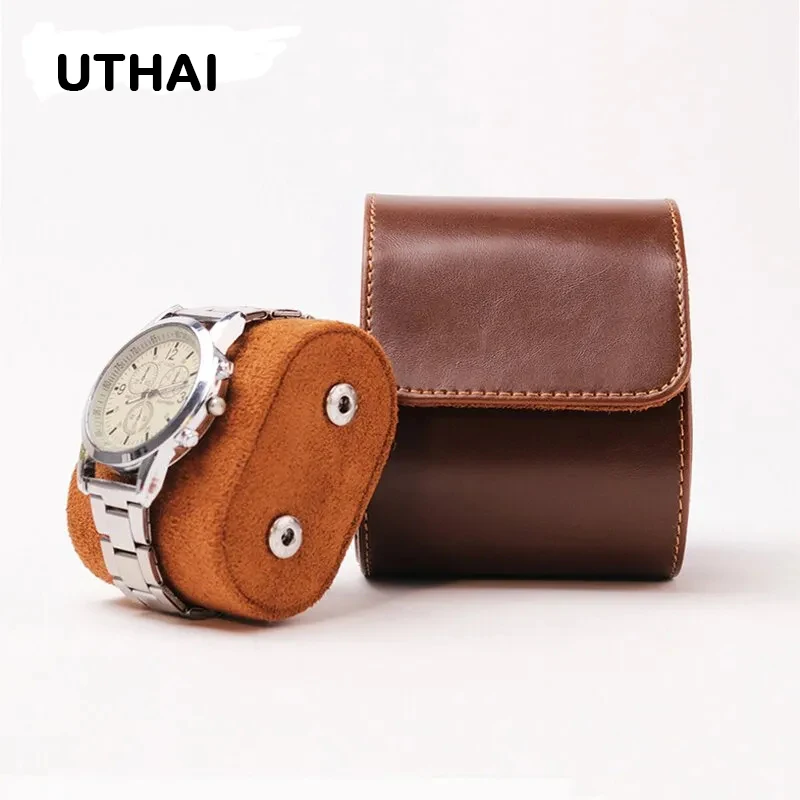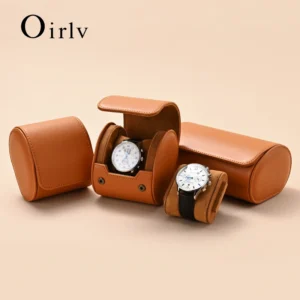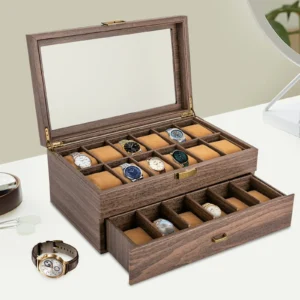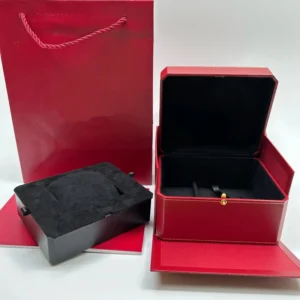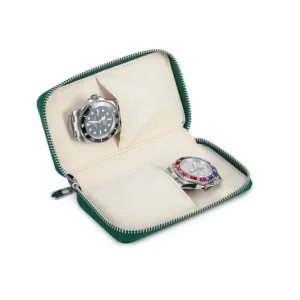Introduction: Why Moisture is Leather’s Greatest Enemy
Leather watch cases and straps represent the perfect blend of luxury and functionality. The soft, supple texture and rich appearance make leather a premium choice for watch enthusiasts. However, this natural material has one significant vulnerability: moisture. Water exposure is the silent destroyer of fine leather watch accessories, causing damage that can drastically reduce both appearance and longevity.
For those who invest in quality timepieces, understanding how to protect leather components from moisture isn’t just helpful—it’s essential. According to industry data, moisture damage accounts for approximately 65% of leather watch strap replacements, making it the leading cause of premature replacement.
This comprehensive guide will walk you through:
– Understanding how moisture affects leather at a molecular level
– Daily habits to prevent water exposure
– Effective cleaning and conditioning techniques
– Specialized treatments and storage solutions
– Emergency response for when moisture exposure occurs
Proper caring for leather watch cases significantly extends their lifespan, preserving both their beauty and value. Premium leather watch boxes offer excellent protection when your timepieces aren’t being worn, but daily care requires additional knowledge and techniques.
Understanding Moisture Damage: How Water Affects Leather Watch Cases
Leather is essentially processed animal skin—a natural material composed of collagen fibers bound together with natural oils. These oils give leather its characteristic suppleness and texture. When moisture enters the equation, several damaging processes begin:
• Discoloration and Water Staining: When water contacts leather, it can carry dissolved minerals and impurities. As the water evaporates, these minerals remain behind, creating visible water spots and discoloration that can appear within hours of exposure.
• Cracking and Stiffness: Water displaces the natural oils in leather. Once dry, the leather fibers no longer have the lubrication they need to remain flexible, leading to stiffness and eventual cracking—often visible within weeks of repeated exposure.
• Warping and Deformation: Leather expands when wet and contracts when drying. This repeated cycle causes the material to warp and lose its original shape, particularly noticeable at strap holes and edges within months.
• Microbial Growth: Damp leather creates the perfect environment for mold and mildew. These organisms can begin growing within 24-48 hours in humid conditions, creating not only unsightly spots but also unpleasant odors.
• Structural Weakening: Over time, moisture breaks down the adhesives used in watch strap construction and weakens stitching. This damage may take months to become visible but eventually leads to complete structural failure.
Fine leather watch cases show moisture damage more prominently than lower-quality materials because their refined finishing highlights any imperfection. Understanding the leather aging process in watch boxes helps explain why proper moisture protection is crucial for preservation.
Essential Daily Habits: Preventing Moisture Exposure
Developing consistent habits is the first line of defense against moisture damage to your leather watch case. These simple daily practices can dramatically extend the life of your leather accessories:
Remove your watch during water activities
* Take off your watch before showering, bathing, or swimming. Even brief exposure to direct water can initiate damage.
* When washing hands, remove your watch beforehand. If you forget, immediately pat dry any water splashes with a soft cloth.
* Avoid wearing leather watches while cooking with steam or water, as vapor can penetrate leather just as effectively as liquid water.Manage body perspiration
* Loosen your watch strap slightly during exercise or in hot weather to minimize sweat accumulation.
* After perspiring, remove your watch and allow both the strap and your wrist to dry completely before wearing it again.
* Consider rotating between multiple straps during humid summer months to allow proper drying time between uses.Implement weather protection strategies
* If caught in unexpected rain, cover your watch with your sleeve or remove it and place it in a pocket.
* For humid environments, store your watch with a small desiccant packet when not in use.
* Adjust your care routine seasonally—more frequent conditioning in dry winter months and more frequent cleaning in humid summer conditions.
Understanding whether you can wear a leather watch every day helps develop appropriate care habits. For those who travel frequently, investing in proper watch travel cases provides essential protection from changing climate conditions and accidental exposure.
Essential Cleaning Techniques for Moisture Resilience
Regular cleaning removes contaminants that can trap moisture against leather surfaces and accelerate damage. Follow these techniques to maintain moisture resilience:
Daily Maintenance Routine:
* Gently wipe down your leather strap each evening with a clean, dry microfiber cloth, working in the direction of the leather grain.
* Inspect for early signs of moisture damage, such as darkening, stiffening, or unusual texture changes.
* Allow your watch to “breathe” overnight by placing it on a watch stand rather than in a sealed container.
Periodic Deep Cleaning Process:
1. Select a leather cleaner specifically formulated for fine leather accessories. Universal leather cleaners often contain harsh detergents inappropriate for watch straps.
2. Apply a small amount of cleaner to a slightly damp cloth—never directly to the leather.
3. Gently wipe the entire surface using circular motions, paying special attention to crevices.
4. Allow to air dry naturally away from heat sources and direct sunlight.
Problem Areas Requiring Special Attention:
* The inside surface that contacts your skin collects oils and perspiration that trap moisture.
* Connection points between the strap and case often accumulate grime that holds moisture.
* Decorative stitching creates tiny pockets where moisture can hide and cause damage.
Avoid common cleaning mistakes that actually introduce moisture, such as oversaturating the leather with cleaner or using household soaps that leave behind residue. Proper leather watch case cleaning techniques remove contaminants without introducing harmful moisture.
Conditioning: The Secret to Moisture-Resistant Leather
Conditioning creates a natural barrier against moisture while restoring essential oils to leather. This process works by replacing the natural oils that are lost through daily wear and environmental exposure, creating a semi-permeable barrier that repels water while allowing the leather to breathe.
Selecting the Right Conditioner:
* Natural oil-based conditioners (like neatsfoot or mink oil) penetrate deeply but may darken leather slightly
* Synthetic blends provide more consistent results without color changes
* Watch-specific leather conditioners contain balanced formulations for thinner, more delicate watch straps
* Look for products free from silicone, alcohol, and petroleum derivatives that can damage fine leather
Application Technique:
* Apply conditioner to a soft cloth rather than directly to leather
* Use a pea-sized amount for an entire watch strap (most people apply too much)
* Work the conditioner in with gentle circular motions
* Allow to absorb for 5-10 minutes, then buff with a clean cloth to remove excess
Conditioning Schedule:
* Every 1-2 months for daily-worn watches in average conditions
* Monthly during dry winter months when indoor heating reduces humidity
* Every 2-3 months for occasionally worn pieces
* When leather feels stiff or lacks luster
Many collectors wonder should you oil leather watch components, and the answer depends on the specific leather type and environmental conditions. For most fine leather watch straps, a dedicated leather conditioner provides better moisture protection than oils alone.
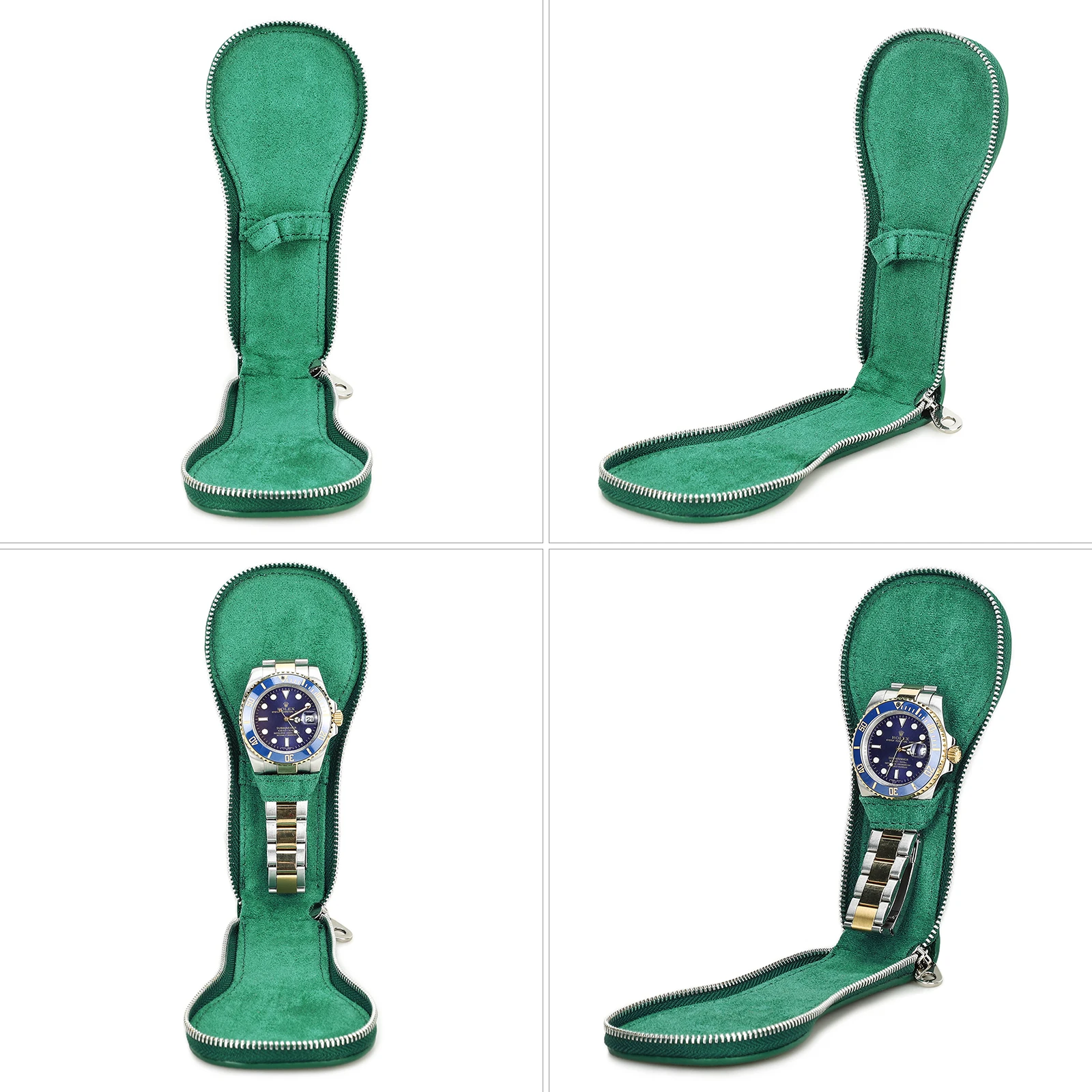
Specialized Water-Repellent Treatments: Pros and Cons
Beyond regular conditioning, specialized treatments can provide additional moisture protection. However, each type comes with its own advantages and limitations:
Types of Leather Waterproofing Products:
| Treatment Type | Advantages | Limitations |
|---|---|---|
| Silicone-based sprays | • Invisible protection • Won’t darken leather • Easy application | • Shorter protection duration • May affect leather breathability • Can build up over time |
| Wax-based treatments | • Longest-lasting protection • Traditional method • Adds rich patina | • May darken leather • Requires more effort to apply • Can feel slightly tacky initially |
| Hybrid protectants | • Balanced properties • Moderate durability • Minimal darkening | • Higher cost • May require specific application tools • Less specialized than other options |
Application Best Practices:
1. Clean and fully dry the leather before application
2. Test on an inconspicuous area first
3. Apply in thin, even coats rather than a single heavy application
4. Allow full curing time (typically 24 hours) before exposure to moisture
5. Reapply according to product instructions, typically every 1-3 months
Effectiveness Limitations:
Remember that these treatments make leather more water-resistant, not waterproof. They will provide protection from light moisture exposure and brief encounters with water but cannot withstand submersion or prolonged exposure. Understanding appropriate cleaning products for leather watch boxes helps select treatments that won’t damage fine leather.
Optimal Storage Solutions: Creating a Moisture-Controlled Environment
How you store your leather watch when not in use significantly impacts its moisture resistance and longevity:
Ideal Environmental Conditions:
* Temperature: 65-75°F (18-24°C)
* Humidity: 45-55% relative humidity
* Air circulation: Gentle air movement without direct drafts
* Light exposure: Minimal, with no direct sunlight
Storage Containers and Accessories:
* Watch boxes with cedar interiors help regulate humidity naturally
* Watch rolls made from microfiber or natural cotton allow leather to breathe
* Pouches should be made from breathable materials, not plastic or vinyl
* Storage cases with transparent tops should use UV-resistant materials
Using Desiccants Effectively:
* Silica gel packets absorb excess moisture and should be placed near (not directly on) leather
* Rechargeable desiccants can be “renewed” by heating according to manufacturer instructions
* Replace or recharge desiccants every 2-3 months or when they change color (if using indicator types)
* Avoid placing desiccants directly against leather as they can over-dry the material
Storage Locations to Avoid:
* Bathrooms (excessive humidity)
* Kitchens (humidity and food odors that leather can absorb)
* Basements or attics (temperature fluctuations and potential dampness)
* Windowsills or areas with direct sunlight (causes leather drying and color fading)
Effective preserving methods for leather watch storage combined with proper watch organizers and accessories create an environment that minimizes moisture exposure while allowing leather to age beautifully.
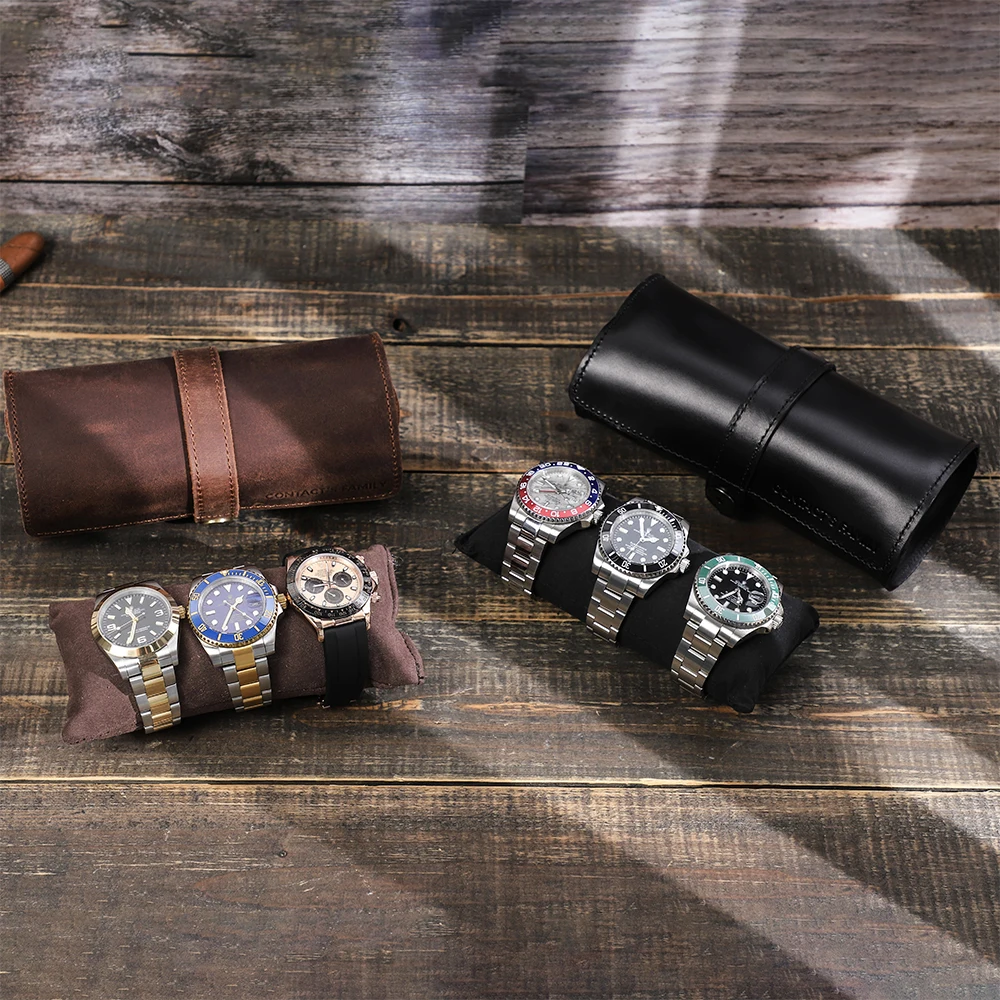
Emergency Response: What to Do When Your Leather Watch Gets Wet
Despite best preventive efforts, accidents happen. When your leather watch does get wet, quick and proper action can minimize damage:
Immediate Action Steps:
1. Gently blot (don’t rub) the leather with a soft, absorbent cloth to remove surface water
2. If possible, remove the strap from the watch case to allow both components to dry properly
3. Position the leather flat on a clean towel in a well-ventilated area away from direct heat sources
Effective Drying Techniques:
* Allow natural air drying for 24-48 hours depending on saturation level
* For light moisture, microfiber cloths can wick away water effectively
* For more severe cases, place (don’t submerge) the leather near silica gel packets or uncooked rice in a container
What NOT to Do:
* Never use hair dryers, radiators, or direct sunlight to speed drying
* Avoid newspaper (the ink can transfer to wet leather)
* Don’t apply conditioner until the leather is completely dry
* Never place wet leather in a sealed container
Post-Drying Care:
1. Once completely dry, assess for damage like water spots or stiffness
2. Apply a small amount of leather conditioner to restore lost oils
3. Monitor for delayed damage such as color changes or warping over the next few days
Understanding proper protecting methods for watches during travel helps prevent emergency situations, especially when visiting humid climates or regions with unpredictable weather.
Watch Accessories, Watch Holder
$94.51 Select options This product has multiple variants. The options may be chosen on the product pageSingle Watch Travel Case, Watch and Jewelry Box, Watch Roll Travel Case
Price range: $93.44 through $140.65 Select options This product has multiple variants. The options may be chosen on the product pageMen's Watch Organizer, Watch Display Case, Watch Organizer
Price range: $112.68 through $169.45 Select options This product has multiple variants. The options may be chosen on the product pageLuxury Watch Boxes, Luxury Watch Travel Case
Price range: $200.33 through $224.57 Select options This product has multiple variants. The options may be chosen on the product pageLeather Watch Travel Case, Men's Watch Travel Case, Watch Roll Travel Case
Price range: $91.37 through $92.63 Select options This product has multiple variants. The options may be chosen on the product pageWatch and Jewelry Box, Watch Drawer Organizer
Price range: $181.91 through $233.38 Select options This product has multiple variants. The options may be chosen on the product page
Understanding Water Resistance: Myths vs. Reality for Leather
There are many misconceptions about leather’s relationship with water. Understanding the facts helps set realistic expectations:
Myth: Leather can be made completely waterproof.
Fact: Leather can be made water-resistant but never truly waterproof. Its natural structure contains pores that will eventually allow water penetration under prolonged exposure.
Myth: Once treated, leather stays water-resistant indefinitely.
Fact: All water-resistant treatments degrade over time and require regular reapplication, typically every 1-3 months depending on wear frequency.
Myth: Water-resistant leather can be submerged safely.
Fact: Even the most effectively treated leather should never be deliberately submerged. Water-resistant treatments only provide protection against brief, light exposure.
Myth: All leather treatments provide the same level of water resistance.
Fact: Different treatments offer varying levels of protection. Wax-based products typically provide better water resistance than oil-based conditioners but may affect the leather’s appearance more significantly.
For activities involving significant water exposure, consider:
* Quick-change straps that allow you to swap your leather strap for a rubber one
* Hybrid leather straps with water-resistant backing
* Saving your leather strap for appropriate occasions and using synthetic alternatives for water activities
Incorporating these insights into your overall leather watch box maintenance routine ensures comprehensive protection for your entire collection.
Advanced Care Strategies for Collectors and Enthusiasts
Serious collectors and enthusiasts may want to implement more sophisticated moisture protection strategies:
Professional Maintenance Schedule:
* Consider professional cleaning annually for valuable or vintage leather straps
* Watch specialists offer services that general leather care professionals may not, including stitch reinforcement and specialized treatments
* While professional services cost $30-100 depending on the piece, this investment can extend the life of premium straps by years
Leather Strap Rotation System:
* Implement a 3-day rest period between wears to allow complete moisture evaporation
* Store unworn straps flat rather than curved to prevent stress on moisture-weakened areas
* Keep a simple log of conditioning dates for each strap to maintain consistent care
Environmental Adaptations:
* For tropical destinations, pack moisture-absorbing silica packets with your watches
* In winter, keep watches away from heaters which create extreme dryness
* Consider small hygrometers (humidity meters) for watch storage areas to monitor conditions
Vintage Leather Preservation:
* Older leather requires more frequent but lighter conditioning
* Focus on maintaining current condition rather than attempting restoration
* Document the appearance with periodic photos to track subtle changes over time
For collectors who travel with valuable timepieces, luxury watch travel cases with controlled environments provide exceptional protection against changing humidity levels and accidental moisture exposure.
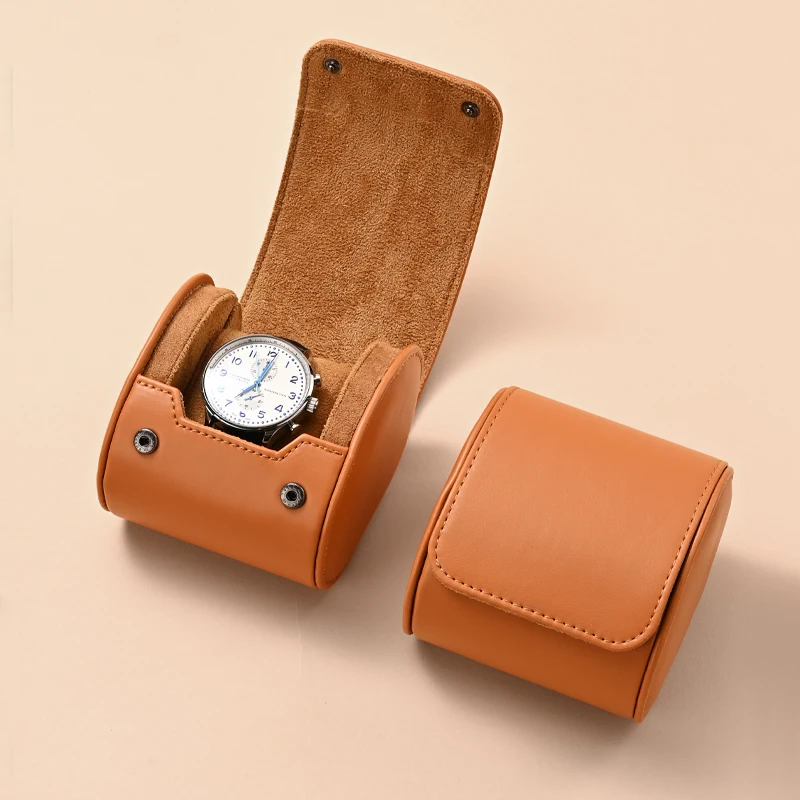
Frequently Asked Questions About Leather Watch Protection
Can I swim with my leather watch strap?
No. Even “water-resistant” leather should never be deliberately submerged in water. Swimming will cause significant damage to leather watch straps.
How often should I condition my leather watch case?
For daily-worn watches, condition every 1-2 months. Increase frequency in dry winter months and decrease slightly in humid summer conditions.
Is rice effective for drying wet leather?
Rice can help draw out moisture from the air around wet leather but should not contact the leather directly. Place the wet leather near (not in) rice in a container with airflow.
Will leather waterproofing sprays change the color or finish?
Most silicone-based sprays won’t change color, but wax and oil treatments typically darken leather slightly. Always test on an inconspicuous area first.
How do I remove water stains from leather?
For fresh stains, blot dry and let air dry completely, then condition. For set-in stains, consult a professional, as DIY remedies often cause more damage than help.
Knowing when to attempt repairs yourself versus seeking professional help is crucial. Understanding leather watch case repair versus replacement options helps make informed decisions when moisture damage does occur.
Protecting Your Investment: Long-Term Leather Care Philosophy
Moisture protection for leather watch cases isn’t just about maintenance—it’s about preserving an investment while enhancing your experience. With proper care, fine leather develops a beautiful patina that tells the story of your journey together, adding character and uniqueness to your timepiece.
By incorporating simple protective habits into your routine, you transform what might seem like a maintenance chore into an appreciation ritual. Each time you clean, condition, or properly store your watch, you’re not just preventing damage—you’re honoring the craftsmanship that went into creating it.
For passionate collectors, protecting leather watches from moisture becomes second nature. Complementing your care routine with quality single watch travel cases ensures your timepieces remain protected whether at home or on the road, preserving both their function and beauty for years to come.
The most effective approach combines knowledge, quality products, and consistent habits—ensuring your leather watch cases remain as beautiful as they are functional throughout their lifetime.

